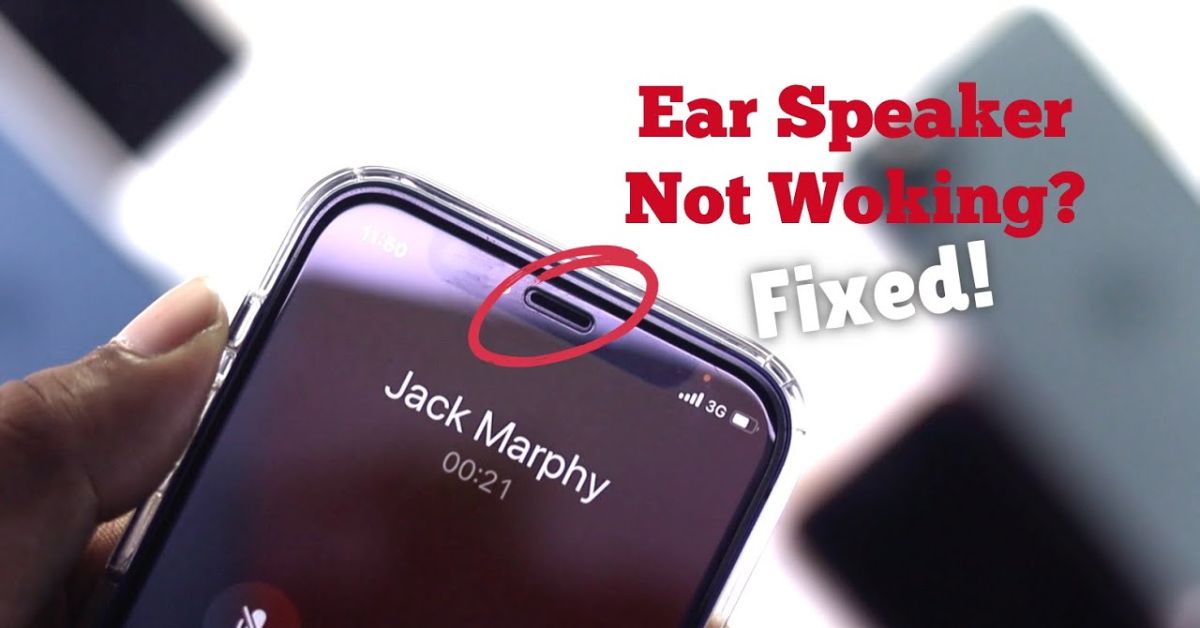If you’ve ever picked up your phone to answer a call and heard nothing, you’re not alone. Many Android users in the USA experience this issue every day. It feels like your phone is working, but when someone speaks, there’s no sound in your earpiece speaker. This can be frustrating, especially if you’re not sure whether it’s a hardware problem, a software bug, or just some dirt stuck inside. In this guide, you’ll discover how to fix ear speaker not working on Android step by step, with clear solutions, tests, and expert advice to help you get your sound back.
Whether you’re dealing with no sound during a phone call, earpiece sound low, or Android speaker settings that seem off, we’ll walk you through the entire process. You’ll also learn about useful tools like the Speaker Cleaning Audio (Fix My Ear Speaker) Tool, how to use the Service Menu for Diagnostic, and how to test if the earpiece speaker problem is really a sign of damage or just a small glitch. Let’s begin.
Here’s the Quickest Way to Fix Ear Speaker – What Worked for Me?
When the ear speaker not working on Android became an issue for me, I assumed the worst—maybe water damage or a broken speaker. But before rushing to a repair shop, I tried a few things at home. The quickest fix turned out to be running a speaker cleaner app and doing a manual sound test. I used the Speaker Cleaning Audio (Fix My Ear Speaker) Tool, which played high-frequency sounds that pushed out dust from the tiny holes of my phone speaker. Surprisingly, within 30 seconds, my earpiece returned to normal. This isn’t a guaranteed fix for everyone, but for many Android users, it’s the fastest way to test if the issue is dust or blockage related. If you want to try it, keep reading for a guide on how to use this audio safely.
How to Quickly Test If Your Ear Speaker Is Faulty
Before doing any advanced troubleshooting, it’s smart to run a few basic tests. Call someone, then switch between earpiece speaker and loudspeaker during the call. If the sound works on loudspeaker but not on the ear speaker, that’s a clear sign the issue is local to that part. You can also use voice recording apps or dial hidden codes like *#0*# or *#*#4636#*#* (depends on your phone model) to open the Service Menu for Diagnostic. There, test the receiver by selecting “Speaker Test.” Apps like “Device Info HW” can also help run speaker diagnostics. If there’s still no audio, this confirms your Android earpiece troubleshooting needs to go deeper.
Troubleshooting Complete!
Once you’ve done your basic testing, it’s time to dive into full troubleshooting. Most earpiece speaker problems are caused by either software bugs, dirt in the speaker grill, or app settings that block sound. In some cases, your phone is just routing audio to a Bluetooth headset or stuck in Do Not Disturb mode. The key is to eliminate all possibilities one by one. If you’re still wondering how to fix ear speakers not working on Android, follow each fix below and apply them in order. The process may take some time, but it often solves even the most stubborn problems without needing a technician.
How To Fix the Ear Speaker (Earpiece) Not Working
Start by thinking about when the issue began. Did it happen after installing a new app? Was your phone exposed to moisture? Or did you update your Android version recently? Sometimes, firmware or software updates can trigger audio bugs, especially in Samsung or Google Pixel devices. Even a small drop of water can cause a sound distortion during call, while dust inside the speaker grill can block sound entirely. In short, the root cause could be physical, software-based, or even linked to audio routing issues. Now, let’s start with the first fix.
Speaker Cleaning Audio (Fix My Ear Speaker) Tool
This method has helped thousands of Android users worldwide. Speaker cleaning audio tools work by playing special tones that push air through the speaker, helping remove dust or moisture. You can find apps like Speaker Cleaner, Fix My Speaker, or Clear Wave on the Google Play Store. These tools are designed for phones with no audio during phone call, especially when the issue is due to phone ear speaker dust or moisture. Just be sure to remove your phone case before use.
How to use this audio:
First, download a speaker cleaner app from the Play Store. Launch the app and place your phone face up on a flat surface. Tap on “Start Cleaning” and let the audio play for 30–60 seconds. You may hear high-frequency or pulsing tones, which is normal. Don’t plug in headphones during this process. After one or two sessions, test your phone by making a call again. This technique can help resolve in-call volume settings problems caused by blocked speakers.
Fix 1: Volume Verification: The Silent Culprit
Believe it or not, the most common cause of an Android call volume issue is the volume itself. The in-call volume settings are different from the media or notification volume. During a call, use the volume buttons to increase the call volume manually. Also, go into Android speaker settings and make sure the call audio slider isn’t turned all the way down. This simple fix solves more problems than you’d think.
Fix 2: The Art of Speaker Cleaning
If you’re dealing with an ear speaker not working on Android, cleaning your earpiece speaker requires care. Use a dry toothbrush or soft-bristled brush to gently clean the speaker grill. If dust is visible, you can use a SIM ejector pin to loosen it—but never push it deep inside. Compressed air can help too, but always spray at an angle, not directly. Some people use isopropyl alcohol with a cotton swab, but that should be a last resort if the speaker is sticky or oily.
Fix 3: Safe Mode: Detective Work in Action
Booting your phone into Safe Mode Android allows you to disable all third-party apps. This helps you find out if any recently installed apps are interfering with your sound. If your ear speaker works fine in Safe Mode, you’ve likely found the issue. Restart your phone normally and start uninstalling apps one at a time until the problem disappears.
Fix 4: The Do Not Disturb Dilemma
Sometimes, Do Not Disturb mode is silently blocking your calls and audio. Go to Settings > Notifications > Do Not Disturb and make sure it’s disabled. Also check if it’s on a schedule (like bedtime mode). If this mode is turned on, it could explain why there’s no sound during call Android.
Fix 5: Bluetooth: The Invisible Audio Thief
Your phone might be sending audio to a Bluetooth audio redirect device even if it’s disconnected. Go to your Bluetooth settings and unpair all devices. Turn off Bluetooth completely and then test your phone call again. Many VoIP apps like Skype or WhatsApp can also default to Bluetooth devices, causing confusion.
Fix 6: The Software Update Solution
Make sure your Android system and apps are fully updated. Outdated firmware can cause sound glitches. Go to Settings > Software Update and install any pending updates. Also, update the Phone app, Google Dialer, and messaging apps to avoid VoIP call audio problems.
Fix 7: Accessibility Settings: The Hidden Influencers
If you’re facing an ear speaker not working on Android, go to Settings > Accessibility > Hearing Enhancements. Look for a Mono audio setting or balance sliders under “Audio Balance.” Sometimes, features like “Hearing Aid Compatibility” may be turned on accidentally, causing sound distortion during calls. Resetting these settings to default often helps resolve the issue and brings back clear in-call audio.
Fix 8: Noise Cancellation
Phones with noise cancellation interference can sometimes misinterpret quiet voices as background noise. Go to call settings and turn off options like “Adaptive Sound” or “Active Noise Control.” This could instantly solve earpiece sound low issues during quiet conversations.
Fix 9: Service Menu for Diagnostic
Use hidden codes like *#0*# to access the phone hardware diagnostic mode. On this screen, tap on “Receiver” and listen for test tones. If no sound plays, the speaker might be damaged. This test helps rule out software issues.
Fix 10: The VoIP Conundrum
Apps like WhatsApp, Skype, or Viber often cause VoIP call audio problems by overriding Android’s default audio settings. Go to the app’s settings and select your preferred audio output. If the issue continues, uninstall and reinstall the app.
Fix 11: Accessibility Settings
You’ve already checked hearing settings, but don’t forget TalkBack and Interaction Control. These can mute or reroute audio. Make sure no accessibility shortcut is enabled by mistake. These settings often get activated accidentally by gestures or app permissions.
Fix 12: The VoLTE and VoWiFi Puzzle
VoLTE call clarity and VoWiFi vs Cellular audio issues are common in newer phones. Try disabling VoLTE in your SIM settings and see if call audio returns. If you’re on Wi-Fi calling, switch to cellular to test. These features often clash depending on your network or location.
Additional Tips
If none of the above fixes worked, you can try a factory reset fix as a last option. Back up your data, then go to Settings > Reset Options > Erase All Data. Before doing that, you may also want to test voicemail, try another SIM card, or use wired earphones temporarily. A voicemail test can help confirm if the issue is on your end or the caller’s.
May Also Read: How to Fix Screen Burn on Phone: The Complete Guide for USA Users
FAQ’s
Why can’t I hear the sound during calls?
The issue is often a mix of earpiece dust, volume settings, or software glitches.
Can moisture cause permanent damage?
Yes, especially if not dried quickly.
Can I fix it without apps?
Yes, through manual cleaning or settings checks.
Should I visit a repair shop?
Only after trying all methods here.
Conclusion
Now you know how to fix an ear speaker not working on Android using proven, step-by-step solutions. From the quickest methods to restore sound to checking accessibility sound settings and using a speaker cleaner sound file, this guide covered it all. Whether your phone has no audio during phone calls or suffers from sound distortion, each fix brings you closer to a fully functioning device. Share this article with anyone dealing with an ear speaker not working on Android—and help them hear clearly again.


